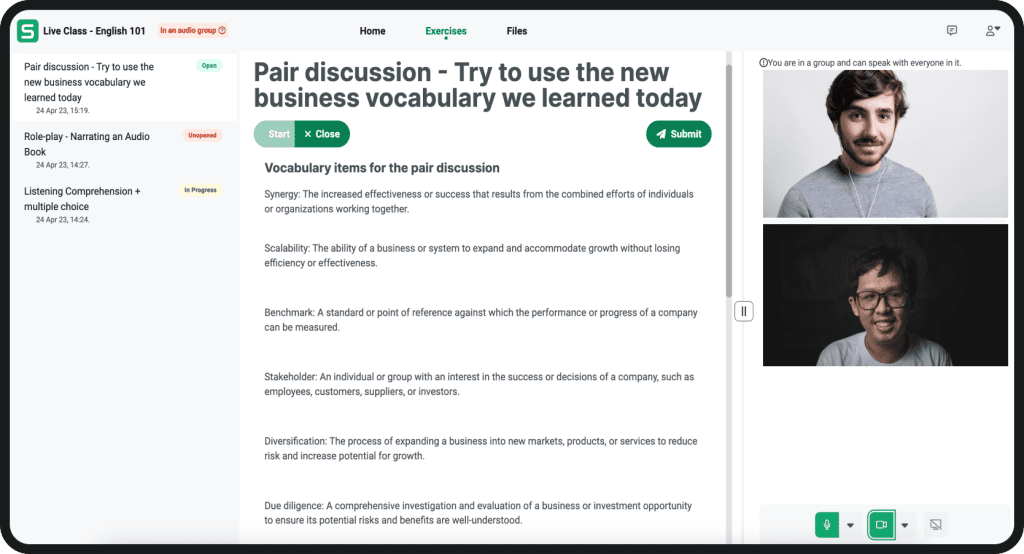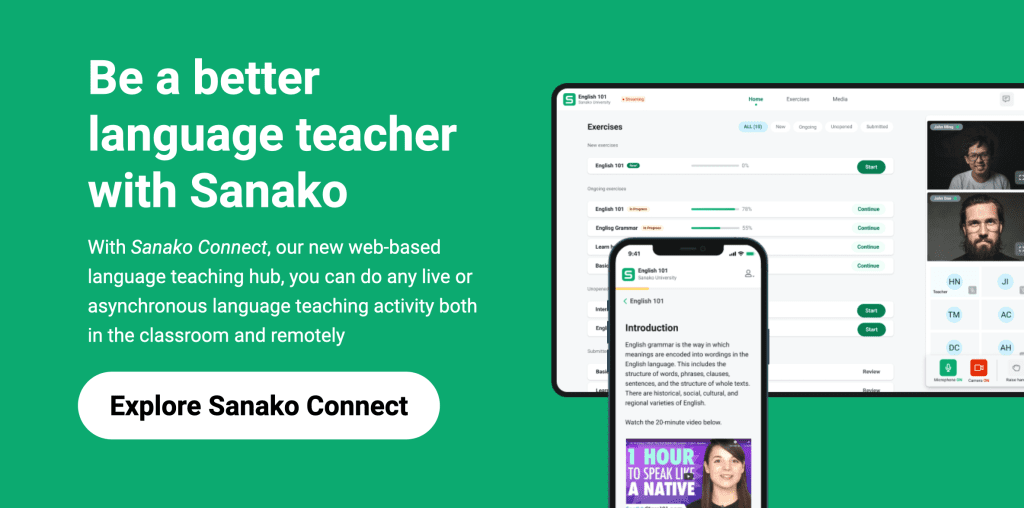In previous blog posts, we’ve covered the importance of practicing the core skills of language learning – listening, reading, speaking, and writing. However, it’s impossible for learners to improve those skills without having a broad (and expanding) vocabulary! Quite simply, learning vocabulary is essential for overall success in any language.
Teaching vocabulary has come a long way from traditional rote learning techniques or simply asking students to copy words from a dictionary. All of the latest research is clear: students need frequent and repeated exposure to new words before they understand them or are able to correctly apply and use them. As this blog post outlines, online language teaching platforms like Sanako Connect can really help learners build vocabulary by providing a variety of opportunities to learn new words.
Reading and listening
Of course, perhaps the most effective way for students to learn new words in context is by regularly exposing learners to them through reading and listening tasks. Encourage your students to pay close attention to, and note down, words that they don’t know. Get them to explore how the words are used and to try and figure out their meaning from the context of the wider text.
Students should also be encouraged to look up words that they don’t know in a dictionary. This will help them to understand their meaning, which can then act as a stimulus for exploring synonyms, example sentences, and pronunciation, for example.
Sanako Connect enables educators to easily share a wide variety of stimulus resources with their students to support vocabulary development. News articles, video clips, web pages or restaurant menus can, for example, be seamlessly integrated into online lesson resources alongside audio or text materials created by the teachers themselves. Educators are also able to create bespoke tasks for students within Sanako Connect, based on this material, to test their listening/reading skills, their comprehension and to help highlight new words to broaden their vocabulary.
Marzano’s 6-step plan
Dr Robert Marzano is an expert in understanding how learners build their vocabularies, having spent thousands of hours observing students and teachers. His conclusions are clear that in all circumstances, direct vocabulary instruction is essential and his research outlines a 6 step plan to incorporate this into teaching.
Step 1: The teacher explains the new word or words, providing a definition and some examples of the word in a relevant context or sentence.
This step aims to build upon students’ existing knowledge and makes frequent use of imagery to help students remember the word.
Sanako Connect online teaching platform enables educators to deliver live lessons to groups of students. Its advanced virtual classroom technology allows students to watch and listen as the educator performs this first step. Depending on the age of the students, educators can either speak the new words directly to the student or use digital flashcards, hand gestures, or mime to explain the words being studied.
Step 2: Students restate or explain the new word in their own words.
In this step, students should be encouraged to respond with their interpretation, either verbally and/or in writing.
Again, Sanako Connect is ideal for facilitating this step. Educators can give each individual student the opportunity to say the word in question either live or via an uploaded sound file created with Sanako’s simple sound recorder. Learners can listen back to and review their recordings at any time.
Students can also use Connect’s free writing space to practice spelling the word and to explain its meaning. Educators can also create (and review) tests and quizzes to review students’ understanding.
Step 3: Ask students to create a non-linguistic representation of the word.
Feedback from educators identifies that this step is particularly important and powerful. When students visualize the word by creating a picture or even by acting out its meaning, their comprehension and achievement soars.
Either in a live or asynchronous setting, Sanako Connect supports students (and educators) to complete this step of the process. Multimedia content of all types (e.g sound files, PDFs, videos) can be easily uploaded by students to illustrate their responses. These can be reviewed by educators either individually or as a class with feedback submitted directly to individual students afterward.
Step 4: Students engage in activities to deepen their knowledge of the new word.
In this stage, the educator seeks to extend and refine students’ understanding of the word. This typically involves the educator creating activities that help students to increase their knowledge by comparing words, classifying terms, or writing their own analogies and metaphors.
Educators can use Connect to provide all students with clear text instructions detailing the activities to be undertaken and associated learning objectives. Alternatively, these can be easily spoken and recorded directly into Connect as required. Connect also provides educators with easily adaptable templates for common language teaching activities. This includes multiple choice quizzes, text entry, gap-fill exercises, and other useful activities.
Step 5: Students discuss the new word in pairs or with partners.
Facilitating language-speaking tasks is at the heart of Sanako Connect. Educators can easily divide students into pairs or small groups for such live discussion. Importantly, each group of students is able to talk simultaneously without distracting each other like in a traditional language lab. The educator can also listen in to the conversation or intervene to provide assistance as required. All conversations can be easily downloaded and reviewed for comment afterward.
Step 6: Students periodically play games to review new vocabulary.
Games, and the whole Marzano approach, fundamentally change the rules of vocabulary learning by making it fun. Playing games with words, or completing tests and quizzes via Sanako Connect, are great ways to help reinforce students’ word knowledge and to build a love of language learning.
If you’d like to find out more about how Sanako’s online language teaching software can transform language teaching in your school or university, click below to learn more and book your free remote demo!


